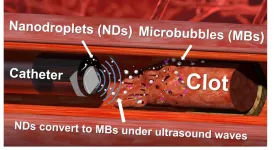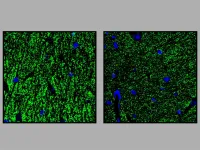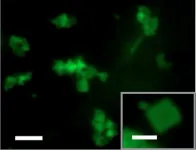(Press-News.org) As the first doses of COVID-19 vaccines are being rolled out, it is still unclear whether enough Americans are willing to be vaccinated to allow the nation to return to normalcy. Many believe a key part of the equation lies in how effective vaccine communication teams are at convincing the public to get vaccinated. And the key to effective communication tactics in promoting the vaccines may lie in demonstrated behavioral economics and consumer behavior theory, experts say.
"The country has made an incredible investment in fast-tracking SARS-CoV-2 vaccines from conception to market, which would make it even more tragic if we fail to curtail the virus simply because Americans are hesitant to be vaccinated," says Stacy Wood, an expert on how consumers respond to change and innovation, and first author of a paper published in the New England Journal of Medicine titled "Beyond Politics - Promoting COVID-19 Vaccination in the U.S." Wood is a professor of marketing and executive director of the Consumer Innovation Collaborative at the NC State Poole College of Management
Recent surveys indicate that the proportion of the U.S. population willing to be vaccinated has fluctuated in recent months - from a high of 72 percent in May, to 51 percent in September and increasing slightly to 60 percent in November. Of those respondents who indicated that they probably or definitely would not get the vaccine, less than half said they might be open to vaccination once others start getting it and more information becomes available.
Since Anthony Fauci has said that at least 80% of the population will need to be vaccinated to get the country back to normalcy, Wood notes that this means it will be necessary to get 100% follow-through from those who are more likely to get the vaccine and 100% conversion of those who are unlikely now but willing to keep an open mind. That's a daunting prospect.
To address this challenge, Wood and her colleague Kevin Schulman of Stanford drew on their expertise in behavioral economics and consumer research to develop 12 strategies that could, collectively, create an effective vaccine-promotion effort.
Proposed strategies include:
Use Analogy: Many attitudes toward the current pandemic are responses to complex medical information. Analogies are short-cuts to conceptual understanding. Saying "the war against COVID" is a term rich in meaning-coming together, making sacrifices, doing tough things, and emerging on the other side with new improvements and inventions in hand. Or one can explain that mRNA vaccines are not weak doses of the virus, but instead are "instruction manuals" that teach the immune system how to defend itself.
Increase Observability: Studies have shown consumers' ability to observe others' choices can increase an innovation's rate of adoption. Distributing tokens, such as Livestrong-style bracelets or stickers, or digital badges, such as social media profile frames, may prove to be effective in increasing consumer buy-in. They can even be specific to different populations (e.g. stickers that say "COVID-19 Frontline Hero -- I'm Vaccinated!" or "America Honors Her Veterans -- I'm Vaccinated!")
Leverage Natural Scarcity: In consumer markets, scarcity often signals exclusivity and prompts greater interest or desirability. Communicators should frame early access to vaccines as a mark of honor or respect for people we want to protect, such as the elderly, teachers or essential workers. Leveraging scarcity, especially as the vaccine is slowly rolled out, may help to counteract many individuals' natural hesitancy to "go first."
Promote Compromise Options: Consider coffee shops that offer three serving sizes and typically sell more of the middle option. This decision rule-of-thumb is based on choice preferences for "compromise" or middle options. When it comes to the vaccine, communicators should not make vaccination seem like an either-or decision, but rather should frame it as three options where vaccination is in the middle. For instance, options could include allowing people to get the shot now, signing up for a later date, or not getting it at all. Or all three options could include the vaccine - such as get the shot now and donate plasma, simply get the shot now, or get the shot later. The key is to avoid depicting vaccination as the most extreme action in a range of choices.
INFORMATION:
For the full list of strategies, see the paper - which is published open access in the New England Journal of Medicine. The paper was authored by Stacy Wood, Langdon Distinguished University Professor of Marketing in NC State's Poole College of Management, and Kevin Schulman, professor of medicine and, by courtesy, of economics, at the Graduate School of Business at Stanford University.
Philadelphia, January 7, 2021 - A new study in the Journal of Nutrition Education and Behavior, published by Elsevier, explores real-time personal and employee safety experiences and perspectives of school nutrition professionals ranging from frontline staff to state leadership across the United States during the early weeks of the coronavirus pandemic.
A survey with both closed- and open-ended items was developed to explore the experiences of school nutrition staff, managers, directors, and state agency personnel. Descriptive statistics from the responses of 47 states ...
The COVID-19 pandemic has seen hardware developers clamouring to make 'open source' technology to support our frontline services. Their intentions have been honourable - an invitation to teams across the world to collaborate in developing essential equipment such as ventilators, thereby making the process of producing critical instruments more effective, both in time and cost.
In practice, however, most developers of hardware have shown little 'openness' in their sharing of designs, a fact lamented by a group of physicists from the University of Bath in the UK, in a paper published this week in The Design Journal.
According to the group, the pandemic has ...
Whenever an organism develops and forms organs, a tumour creates metastases or the immune system becomes active in inflammation, cells migrate within the body. As they do, they interact with surrounding tissues which influence their function. The migrating cells react to biochemical signals, as well as to biophysical properties of their environment, for example whether a tissue is soft or stiff. Gaining detailed knowledge about such processes provides scientists with a basis for understanding medical conditions and developing treatment approaches.
A team of biologists and mathematicians at the Universities of Münster and Erlangen-Nürnberg has now developed a new method for analysing cell migration ...
Engineering researchers have developed a new technique for eliminating particularly tough blood clots, using engineered nanodroplets and an ultrasound "drill" to break up the clots from the inside out. The technique has not yet gone through clinical testing. In vitro testing has shown promising results.
Specifically, the new approach is designed to treat retracted blood clots, which form over extended periods of time and are especially dense. These clots are particularly difficult to treat because they are less porous than other clots, making it hard for drugs ...
PHILADELPHIA - Medical school curriculums may misuse race and play a role in perpetuating physician bias, a team led by Penn Medicine researchers found in an analysis of curriculum from the preclinical phase of medical education. In a perspective piece published Tuesday in the New England Journal of Medicine, the researchers identified five key categories in which curriculum misrepresented race in class discussions, presentations, and assessments. The authors recommend that rather than oversimplifying conversations about how race affects diseases' prevalence, diagnosis, and treatment, medical school faculty must widen the lens to "impart an adequate and accurate understanding of the complexity ...
FOR IMMEDIATE RELEASE
In what is believed to be the most comprehensive molecular characterization to date of the most common type of head and neck cancer, researchers from the Johns Hopkins departments of END ...
As the planet continues to warm, the twin challenges of diminishing water supply and growing energy demand will intensify. But water and energy are inextricably linked. For instance, nearly a fifth of California's energy goes toward water-related activities, while more than a tenth of the state's electricity comes from hydropower. As society tries to adapt to one challenge, it needs to ensure it doesn't worsen the other.
To this end, researchers from UC Santa Barbara, Lawrence Berkeley National Laboratory and UC Berkeley have developed a framework to evaluate how different climate adaptations may impact this water-energy nexus. Their research appears in the open access journal Environmental Research Letters.
"Electricity and water systems are linked in many ...
Impaired intelligence, movement disorders and developmental delays are typical for a group of rare diseases that belong to GPI anchor deficiencies. Researchers from the University of Bonn and the Max Planck Institute for Molecular Genetics used genetic engineering methods to create a mouse that mimics these patients very well. Studies in this animal model suggest that in GPI anchor deficiencies, a gene mutation impairs the transmission of stimuli at the synapses in the brain. This may explain the impairments associated with the disease. The results are now published ...
INDIANAPOLIS-- Researchers at the Indiana University Melvin and Bren Simon Comprehensive Cancer Center published promising findings today in the New England Journal of Medicine on preventing a common complication to lifesaving blood stem cell transplantation in leukemia.
Sherif Farag, MD, PhD, found that using a drug approved for Type 2 diabetes reduces the risk of acute graft-versus-host disease (GVHD), one of the most serious complications of blood stem cell transplantation. GVHD occurs in more than 30 percent of patients and can lead to severe side effects and potentially fatal results. Farag is ...
Chemists have developed a nanomaterial that they can trigger to shape shift -- from flat sheets to tubes and back to sheets again -- in a controllable fashion. The Journal of the American Chemical Society published a description of the nanomaterial, which was developed at Emory University and holds potential for a range of biomedical applications, from controlled-release drug delivery to tissue engineering.
The nanomaterial, which in sheet form is 10,000 times thinner than the width of a human hair, is made of synthetic collagen. Naturally occurring collagen is the most abundant protein in humans, making the new material intrinsically biocompatible.
"No one has previously made collagen ...



